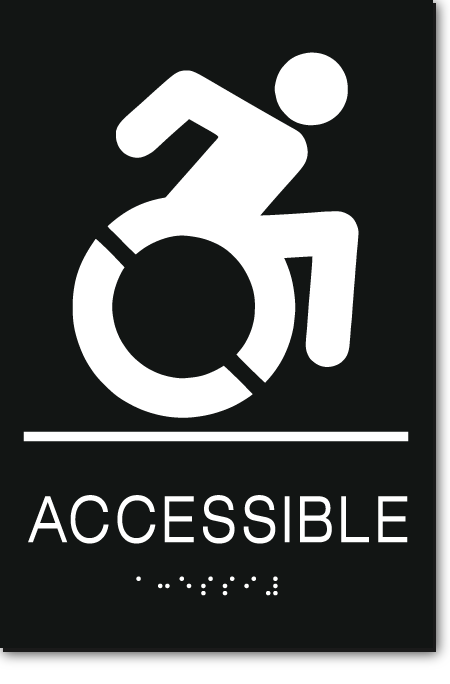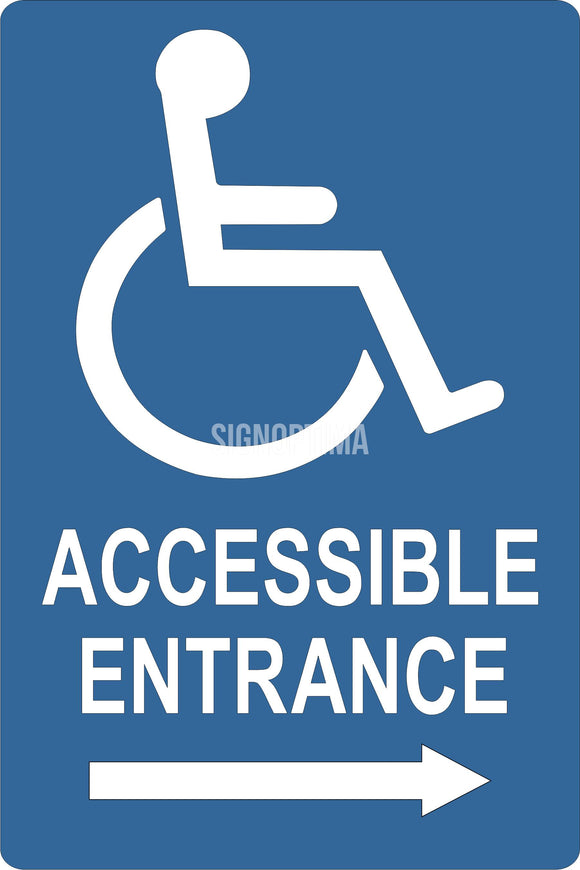Exploring the Key Functions of ADA Signs for Boosted Ease Of Access
In the world of availability, ADA indications serve as silent yet powerful allies, making certain that spaces are navigable and inclusive for people with disabilities. By incorporating Braille and tactile components, these indications break barriers for the aesthetically impaired, while high-contrast color systems and readable fonts cater to diverse visual demands.
Importance of ADA Compliance
Making certain conformity with the Americans with Disabilities Act (ADA) is crucial for promoting inclusivity and equal accessibility in public spaces and workplaces. The ADA, enacted in 1990, mandates that all public centers, companies, and transportation services suit individuals with impairments, guaranteeing they enjoy the exact same civil liberties and opportunities as others. Conformity with ADA criteria not just satisfies lawful obligations yet likewise improves a company's credibility by showing its dedication to diversity and inclusivity.
One of the key aspects of ADA compliance is the implementation of accessible signs. ADA indicators are designed to make certain that people with specials needs can quickly navigate via structures and spaces.
Furthermore, adhering to ADA regulations can minimize the danger of possible fines and lawful consequences. Organizations that fail to abide with ADA guidelines might deal with claims or fines, which can be both monetarily challenging and harmful to their public photo. Thus, ADA conformity is important to fostering an equitable atmosphere for every person.
Braille and Tactile Aspects
The incorporation of Braille and tactile components into ADA signage symbolizes the concepts of ease of access and inclusivity. These attributes are important for individuals who are blind or aesthetically impaired, allowing them to browse public spaces with higher freedom and confidence. Braille, a responsive writing system, is important in supplying composed info in a format that can be conveniently regarded through touch. It is normally positioned below the equivalent text on signage to make sure that people can access the details without visual help.
Tactile aspects prolong beyond Braille and include raised personalities and symbols. These elements are designed to be noticeable by touch, permitting people to identify room numbers, restrooms, departures, and various other critical areas. The ADA sets details standards concerning the size, spacing, and positioning of these responsive components to enhance readability and make sure uniformity across various atmospheres.

High-Contrast Shade Schemes
High-contrast color design play a crucial role in boosting the exposure and readability of ADA signs for people with aesthetic impairments. These systems are important as they take full advantage of the difference in light reflectance between text and history, guaranteeing that signs are conveniently discernible, also from a distance. The Americans with Disabilities Act (ADA) mandates the usage of specific shade contrasts to fit those with minimal vision, making it an important element of conformity.
The efficacy of high-contrast shades hinges on their ability to stick out in various illumination conditions, including dimly lit atmospheres and areas with glare. Generally, dark text on a light history or light text on a dark history is employed to achieve optimum comparison. For example, black message on a white or yellow background gives a plain visual difference that aids in quick acknowledgment and comprehension.

Legible Fonts and Text Dimension
When taking into consideration the design of ADA signage, the option of readable fonts and ideal text size can not be overstated. The Americans with Disabilities Act (ADA) mandates that fonts have to be sans-serif and not italic, oblique, manuscript, very decorative, or of uncommon form.
According to ADA guidelines, the minimum text elevation ought to be 5/8 inch, and it needs to enhance proportionally with checking out distance. Uniformity in message size adds to a natural view it aesthetic experience, aiding people in navigating atmospheres effectively.
Furthermore, spacing in between lines and letters is indispensable to legibility. Appropriate spacing stops characters from appearing crowded, improving readability. By sticking to these criteria, developers can dramatically boost access, ensuring that signage serves its desired function for all individuals, no matter their visual abilities.
Effective Positioning Approaches
Strategic placement of ADA signs is vital for optimizing accessibility and making sure compliance with legal criteria. ADA standards stipulate that indicators must be mounted at a height in between 48 to 60 inches from the ground to ensure they are within the line of view for both standing and seated people.
Furthermore, indications have to be placed beside the latch side of doors to enable very easy identification prior to entry. This placement assists individuals find rooms more and rooms without blockage. In cases where there is no door, indicators should be located on the nearby nearby wall surface. Consistency in sign placement throughout a center boosts predictability, decreasing complication and enhancing general customer experience.

Verdict
ADA signs play an important role in promoting availability by integrating attributes that deal with the demands of people with impairments. Including Braille and tactile aspects makes certain essential details comes to the visually damaged, while high-contrast color pattern and understandable sans-serif typefaces enhance exposure across numerous lights conditions. Reliable positioning methods, such as ideal placing heights and tactical locations, further assist in navigating. These aspects jointly cultivate a comprehensive setting, emphasizing the significance of ADA conformity in ensuring equal access for all.
In the world of access, ADA indications serve as silent yet effective allies, making certain that areas are inclusive and accessible for people with disabilities. The ADA, passed in 1990, mandates that all public facilities, companies, and transportation services fit individuals with handicaps, guaranteeing they take pleasure in the same civil liberties and chances as others. ADA Signs. ADA indications are developed to ensure that people with handicaps can quickly browse with structures and areas. ADA standards specify that indicators this post need to be mounted at a height between 48 to 60 inches from the ground to guarantee they are within the line of sight for both standing and seated people.ADA signs play an essential duty in promoting ease of access by incorporating functions that resolve the needs of individuals with specials needs